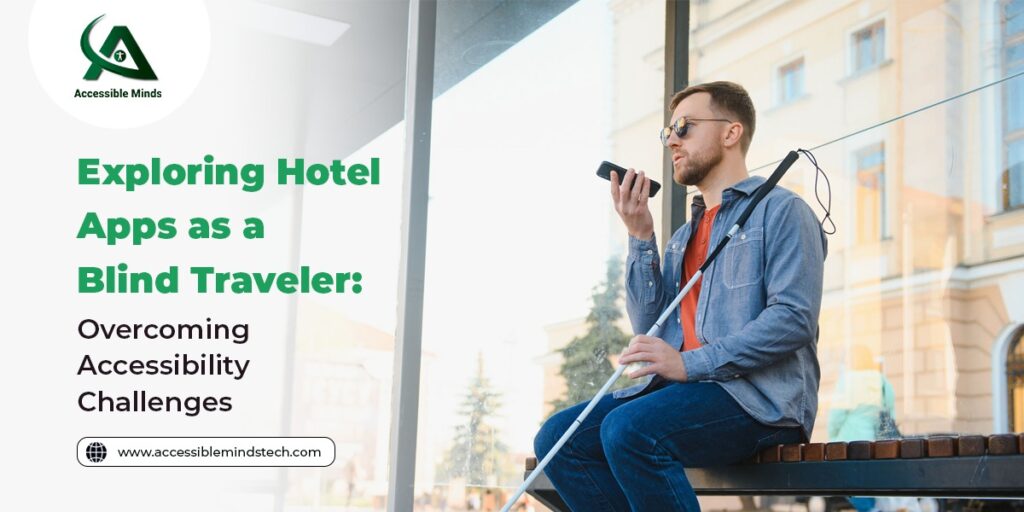Traveling can be a thrilling experience, but for blind travelers, the journey often comes with a unique set of challenges, particularly when it comes to accessing information through digital platforms. Hotel apps, in particular, are essential tools for booking, check-in, navigation, and accessing services. However, ensuring these apps are accessible to blind users requires a deep understanding of digital accessibility services.
The Importance of Digital Accessibility Services
Digital accessibility services are crucial for creating inclusive digital environments. These services ensure that websites and applications are usable by people with various disabilities, including blindness. For hotel apps, this involves integrating features that allow blind users to navigate and interact with the app using assistive technologies like screen readers.
Screen readers are software programs that read out the text displayed on a screen. They are essential for blind users to access digital content. However, for screen readers to work effectively, apps must be designed with accessibility in mind. This means following guidelines such as the Web Content Accessibility Guidelines (WCAG), which provide a comprehensive framework for making digital content accessible.
Challenges Faced by Blind Travelers
Blind travelers face several challenges when using hotel apps:
- Navigational Difficulties: Many hotel apps are not designed with proper labeling of buttons and links, making it difficult for screen readers to interpret and relay information to the user.
- Lack of Descriptive Text: Images and icons without alternative text descriptions can render crucial information inaccessible to blind users.
- Complex Interfaces: Overly complex interfaces with too many interactive elements can overwhelm screen readers and users, making navigation frustrating and inefficient.
- Booking and Check-in: The process of booking a room and checking in can be particularly challenging if the app is not designed to be accessible, leading to potential errors and delays.
Overcoming Accessibility Challenges
To illustrate how these challenges can be overcome, let’s look at two examples of hotel apps that have integrated digital accessibility services effectively.
Example 1: Marriott Bonvoy App
The Marriott Bonvoy app is a good example of an app that has made significant strides in accessibility. Marriott International has committed to ensuring its digital platforms are inclusive and accessible to all users. The app includes features such as:
- VoiceOver Compatibility: For iOS users, the app is fully compatible with VoiceOver, Apple’s built-in screen reader. This means that all interactive elements are labeled correctly, allowing blind users to navigate through the app seamlessly.
- Descriptive Text: The app includes alternative text for images and icons, ensuring that all visual elements are described to the user. This is crucial for providing context and making sure users do not miss out on important information.
- Simplified Navigation: The app’s interface is designed to be straightforward, with clear and concise navigation paths. This reduces the cognitive load on users and makes it easier for screen readers to interpret and relay information.
By focusing on these aspects, Marriott has managed to create an app that is more inclusive and user-friendly for blind travelers.
Example 2: Hilton Honors App
Hilton has also invested in digital accessibility services to enhance the usability of its Hilton Honors app. Key features include:
- Screen Reader Support: The app is compatible with screen readers on both iOS and Android platforms. This ensures that blind users can access all features of the app, from booking a room to checking in and accessing hotel services.
- Accessible Booking Process: Hilton has streamlined its booking process to be accessible. This includes clearly labeled buttons, simplified forms, and an intuitive interface that works well with screen readers.
- Customizable Accessibility Settings: The app allows users to customize accessibility settings according to their preferences. This includes adjusting text size, contrast, and other visual elements to suit individual needs.
These efforts by Hilton demonstrate how a commitment to accessibility can significantly enhance the user experience for blind travelers.
The Role of Digital Accessibility Services Providers
The success of apps like Marriott Bonvoy and Hilton Honors in making their platforms accessible is often attributed to their collaboration with digital accessibility services providers. These providers offer expertise in designing and implementing accessibility features, ensuring compliance with guidelines like WCAG, and conducting usability testing with real users with disabilities.
Services typically offered by digital accessibility providers include:
- Accessibility Audits: Comprehensive reviews of apps and websites to identify accessibility issues and recommend improvements.
- Design Consultation: Guidance on designing interfaces that are accessible from the ground up, including proper labeling, color contrast, and navigational structures.
- User Testing: Involving blind users and other individuals with disabilities in the testing process to gather feedback and ensure the app meets their needs.
- Training and Support: Providing training for development teams on best practices for accessibility and ongoing support to maintain accessibility standards.
Conclusion
For blind travelers, the journey can be made significantly easier with the help of accessible hotel apps. By leveraging digital accessibility services, hotel chains like Marriott and Hilton have set a standard for creating inclusive digital experiences. These efforts not only enhance the travel experience for blind users but also contribute to a more inclusive and accessible digital world for everyone. As more companies recognize the importance of digital accessibility, the hope is that these standards will become the norm, making travel and other everyday activities more accessible to all.

